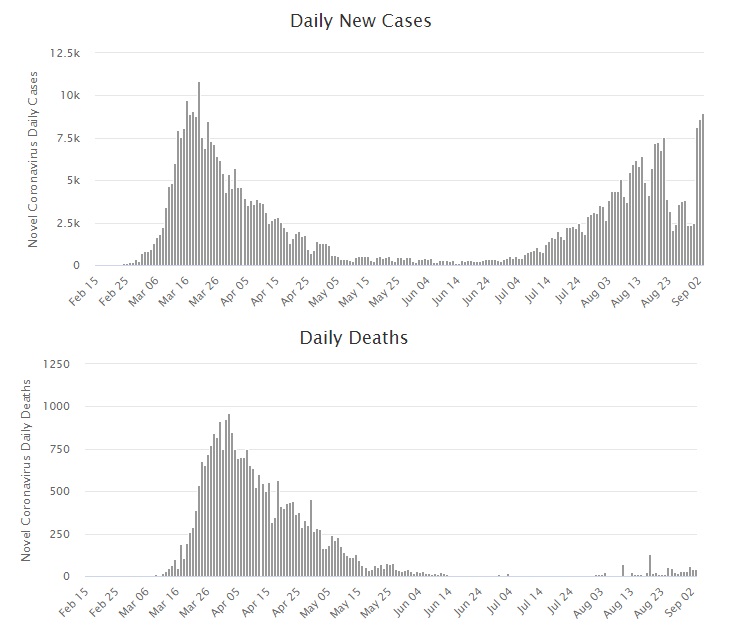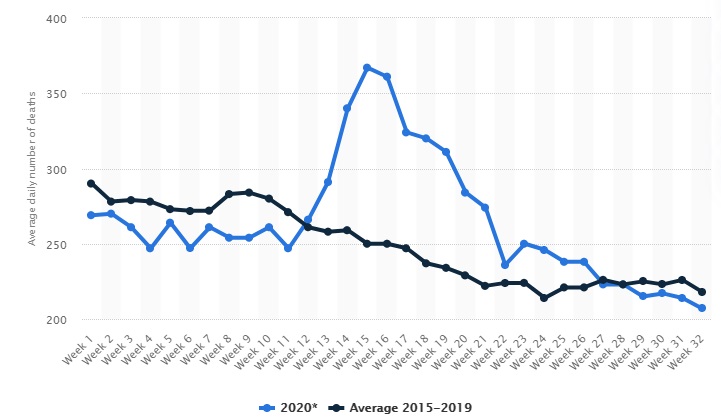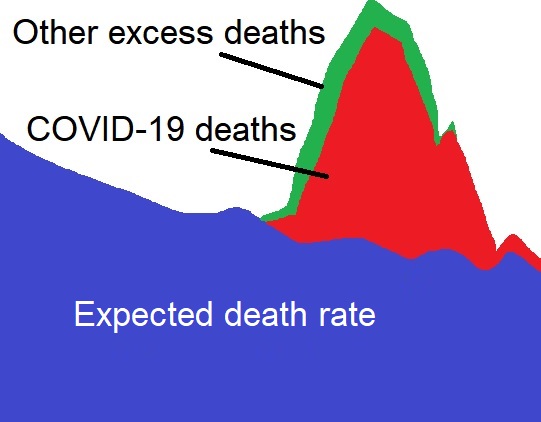COVID-19 is a dangerous disease. And there are many reasons why is it so.
However, since various prolonged lockdown measures were implemented across the globe to slow the spread of it, people got tired of them. And many started asking whether the lockdown measures are actually deadlier than the virus itself.
And these questions are not entirely baseless and aren’t only being asked by mad conspiracy theorists. For example, the data clearly indicates that the vast majority of people who die with COVID-19 are elderly and have existing health issues. In fact, the majority of deaths occur within the age range of the people who die from natural causes.

Of course, any death is a tragedy. But based on this data, it is not clear how many of the COVID-19 deaths were people who would have died anyway even if they didn’t get infected with COVID-19. This is precisely why it’s more accurate to say that someone has “died with COVID-19” rather than “died from COVID-19”.
Another reason why people are questioning whether strict lockdown measures are deadlier than COVID-19 itself is the fact that, when the second spike of COVID-19 cases has occurred in European countries, if wasn’t followed by a steep spike of deaths like the first spike did. For example, here is the data for Spain:

During the first spike of cases, which has occurred between March and May 2020, the whole of Spain was under a strict lockdown. During the second spike of cases, which has occurred after mid-July, some localized measures were introduced in some parts of the country, but they were nowhere near as strict as the full lockdown imposed previously.
During the first spike, nobody was allowed to leave home without a good reason and many businesses were forced to close. During the second spike, however, there were some nightclub closures. mandatory wearing of masks, and limits imposed on how many people can gather in one place. But overall, these measures didn’t disrupt ordinary life anywhere near as much as the full lockdown did prior to this. So, could it be that the lockdown measures that caused the majority of these deaths rather than COVID-19?
Today we will try to answer the question of what is more deadly – COVID-19 or full lockdown. Of course, we will completely disregard any crazy unfounded conspiracy theories about COVID-19. So, we will not talk about founders of IT companies trying to control world population by violating known laws of physics via a vaccine. We will only examine logical arguments and have a look at the actual data that is available to the public.
How do we even know that COVID-19 kills?
The total number of COVID-19 deaths for a given country can be deceptive and it doesn’t necessarily show us how deadly the virus is. This is primarily because almost all people who die with COVID-19 are either at the age when the likelihood of dying from natural causes is high or have other serious illnesses.
These factors make it difficult to determine how many of these people would have passed away even if they wouldn’t have gotten infected with COVID-19. And experienced medical doctors admit that it’s often difficult to determine whether someone’s death was actually caused by COVID-19 or whether the person simply have happened to contract the disease shortly before passing away.
So, to determine how deadly COVID-19 is, we need to have a look at so-called “excess deaths”. This is the number of deaths over and above the normal death rate for a particular time of year. If the majority of COVID-19 deaths would have happened anyway, then there would be a small spike of excess deaths, while if the virus actually kills, there will be a substantial spike.
And to check whether there is a significant number of excess deaths happening during COVID-19 pandemic, we can have a look at statistics from Sweden. Among the developed countries that are known to publish reliable statistics, it was the only country that has implemented the minimal amount of anti-pandemic measures and did not impose a strict lockdown. Therefore, it would be easier to rule out excess deaths due to the lockdown measures themselves.
Of course, we could have chosen Belarus as an example, because it was the only country in the world that didn’t take any anti-pandemic measures at all. However, because it’s a country where a deeply unpopular president wins an election with 80% of the vote according to the official data, we can’t trust any official data from there at all. So, we’ll stick with Sweden:

The graph is not drawn to scale. There were roughly third more deaths registered in Sweden during the peak of the pandemic than the average number of deaths for the same period within the last five years prior. So, we can confidently say that COVID-19 does significantly increase mortality.
Now, let’s have a look at UK as an example of a country that imposed very strict lockdown rules during the peak of the pandemic. The picture looks like this:

This graph is more detailed and is drawn to scale. Just like the previous graph, this one also shows a noticeable peak in excess deaths. But this time, the number of registered deaths during the peak of the pandemic is roughly double of that of the normal rate. So, at the first glance, it appears that strict quarantine measures are not merely ineffective against preventing people from dying, but they actually make the situation worse.
By looking at this graph, it becomes apparent that the peak in COVID-19 deaths roughly corresponds with the peak in deaths overall. This is why the data is often plotted like this:

But there are also people who believe that the number of COVID-19 deaths is underestimated. So they believe that the actual situation is like this:

On the other hand, there are also people who realize that a proportion of official COVID-19 deaths is represented by people who would have died anyway. Some also believe that a proportion of COVID-19 deaths is represented by people dying with COVID-like symptoms without actually having COVID-19, as healthcare system doesn’t have resources to conduct proper laboratory tests every time. So they view they view the situation like this:

But there is no need to speculate which of these views is correct. We can have a look at the actual data and settle the argument once and for all.
What the official UK deaths statistics say?
Once again, we will have a look at the official data available in the UK, which is collected, published and summarized by Office for National Statistics (ONS).
To find out whether anti-COVID measures kill, we can have a look at deaths by all causes. For example, when we had peak excess deaths, perhaps we had significantly more people dying from substance abuse. After all, we know that alcohol sales have risen a lot during the pandemic. People do get depressed due to self-isolation and by being forced to lose their source of income, so they drink more. Some start to consume more illegal drugs. There also might be a substantial increase in suicides for exactly the same reasons.
Not all cohabitants get along well and when they don’t, forcing them to spend 24-7 in the same house is a recipe for disaster. So, perhaps we are expected to see more deaths caused by domestic violence.
There also might be increase in people dying because they can’t get required healthcare on time. This is plausible, as the healthcare system was geared to primarily deal with COVID-19 patients, while everyone else was a lower priority.
But at the same time, we also need to have a look at the death numbers being offset in other areas. For example, there was a substantial decrease in car usage during the lockdown. So, perhaps there is a sharp decrease of deaths in road traffic accidents.
Well, we should hope to be able to answer all these questions by looking at the official deaths statistics. So this is precisely what I did.
Unfortunately, this didn’t help. The problem with the official death statistics in the UK is that the dataset that is split into individual causes of death only gets published once a year. The dataset that gets updated on weekly basis only lists the total number of deaths, number of deaths from respiratory illnesses and, for the dataset from 2020, COVID-19 deaths.
Essentially, the datasets for 2019 and 2020 look like this:


I also couldn’t help but to notice a detail that can be open to misinterpretation. There is the following note on the 2020 dataset:
Note: Deaths could possibly be counted in both causes presented. If a death had an underlying respiratory cause and a mention of COVID-19 then it would appear in both counts.
And this is why this is significant. Most of the public is aware that COVID-19 is a respiratory illnesses. So, if we have data for all respiratory illnesses, then that number should include COVID-19 deaths. However, what we see instead is that the number of deaths from respiratory illnesses doesn’t change by much from the last year, while the number of COVID-19 deaths is several times that number at the peak of the pandemic.
What’s going on here? Aren’t COVID-19 deaths respiratory? Is someone making the numbers up? And this is precisely how most conspiracy theories are born – making hasty conclusion after examining real data, but not doing it thoroughly enough.
Well, it’s not the case. The row that show respiratory illnesses doesn’t show all respiratory illnesses. It only shows deaths from specific conditions where codes J00 to J99 apply. COVID-19 has its own code – U07. And this is why these two numbers hardly overlap. COVID-19 deaths will only be registered in both categories if the person also had other respiratory illness.
But, despite other causes of deaths not being listed, the number of COVID-19 deaths does look like the biggest killer, as, for particular weeks, it reaches almost 50% of total deaths. It’s extremely unlikely that any other cause of death can represent the rest of them. Also, the shape of the graph representing excess deaths closely matches with the shape of the graph representing COVID-19 deaths, which suggests it was COVID-19 that caused the majority of excess deaths.
So, based on these facts, we can conclude that COVID-19 is indeed the biggest killer. Unless, of course, the numbers of COVID-19 deaths are exaggerated.
Can COVID-19 deaths be exaggerated?
In a way, we have already answered this question by suggesting that people who would already have died from natural causes are registered as COVID-19 deaths if they happen to contract the disease before they pass away. But because the shape of the graph showing COVID-19 deaths is similar to the shape of the graph showing excess deaths, the conclusion is that the majority of COVID-19 deaths are the people who wouldn’t have died if they wouldn’t have contracted COVID-19.
But this conclusion only works if almost all registered COVID-19 deaths are indeed COVID-related. But what if many of them aren’t?
After all, even the UK officials have admitted that many COVID-19 deaths were due to other unrelated causes. UK government has even ordered a review into them. The problem was that a person who would get COVID-19 would be registered as COVID-19 death even if the death occurred months after the person had the illness.
There are also some anecdotal reports of people having been put COVID-19 on the death certificate as the cause of death even when they were completely unsymptomatic and and never had any COVID-19 tests done. Can there be any truth to it, or is this simply a conspiracy theory?
Well, as a matter of fact, it is possible. An official guidance given to the NHS doctors has stated that they should put COVID-19 as the cause of death on the death certificate if the patient exhibits any known symptoms of the disease, even when there is no laboratory test available. And there was shortage of tests at the beginning of the pandemic So, it is plausible that some people who have exhibited COVID-like symptoms have died of a completely different illnesses, while still being registered as COVID-19 casualties.
But what about asymptomatic patients? Well, this is not entirely implausible either. The official guidance says that the NHS doctors should use their own judgement when registering the cause of death. And, although COVID-19 is primarily a respiratory illness, it is known to cause major problems all over the body. A person with the virus can die from heart attack, stroke or kidney failure. These types of deaths are fairly common among the elderly. So it is possible that some of these deaths have been added to COVID-19 death statistics even when they had nothing to do with COVID-19.
But I would trust the professionalism of the NHS doctors. After all, they spend years studying and have to pass a rigorous selection process. Those who are incapable of good judgement simply don’t make it into the profession.
So, even if there were the cases of mis-identifying a non-COVID deaths as COVID-related, they would only be isolated cases. Overall, the picture would remain the same – the majority of excess deaths were indeed caused by COVID-19.
But the matter is not settled yet. There is still another factor to consider.
Official report confirms that lockdown kills
The UK government has published a report that confirms that around 40% of excess deaths were caused by people being unable to obtain medical services, as the entire healthcare system was geared to fight the pandemic. That’s 16,000 deaths out of the total of 38,500 excess deaths registered.
And these report didn’t even taken other possible lockdown deaths into account. It didn’t have a look into a possible increase in suicides or deaths due to substance abuse. So the number of excess deaths directly caused by lockdown measures may well be well over 40%.
Conclusion
COVID-19 kills. There is no doubt about it. But excessively strict lockdown measures also kill.
Perhaps lockdown measures don’t cause as much harm as COVID-19, but they do cause a substantial amount of harm nonetheless.
Of course, it is necessary to take some anti-pandemic measures. Otherwise the virus may get completely out of control and the healthcare system will be overwhelmed. But we need to be careful not reach a point where additional intrusive measures don’t provide additional benefits.
UK has clearly reached this point. As a country that has introduced excessively strict lockdown measures, it did worse than Sweden, which hardly introduced any measures at all. While, at the peak of the pandemic, Sweden had deaths rising by a third above the normal range, in UK, the death rate has doubled.
Another unintended negative side-effect of excessively strict lockdown measures is that people get tired of them. So, later, when even simple and relatively unobtrusive sets of rules are introduced, like a requirement to wear a face covering while shopping, people refuse to abide by those rules. Some even go as far as organising massive protests, further increasing the risk of a new spike in infections.
So, while we definitely need to take measures to fight the pandemic, those measures should be smart, fine-grained and targeted. We should never return to a full lockdown and a shutdown of the entire economy.
